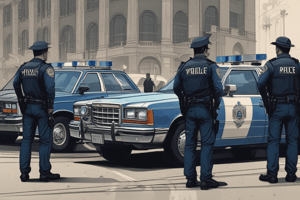Podcast
Questions and Answers
What is the primary importance of witness descriptions in police investigations?
What is the primary importance of witness descriptions in police investigations?
- They provide an alibi for the suspect.
- They often result in identifying suspects. (correct)
- They can lead to dismissing charges.
- They are primarily used for generating case reports.
What procedural step must be taken with the witness's first description?
What procedural step must be taken with the witness's first description?
- It must be recorded accurately and in detail. (correct)
- It should be rewritten for clarity.
- It should be withheld until further evidence is gathered.
- It is optional if the witness was unsure.
Which identification method is NOT mentioned in relation to child witnesses?
Which identification method is NOT mentioned in relation to child witnesses?
- Voice recognition technology. (correct)
- Use of photographs.
- Descriptions from eye witnesses.
- Electronic facial identification.
When establishing the identity of a suspect, what is an alternative method besides witness descriptions?
When establishing the identity of a suspect, what is an alternative method besides witness descriptions?
How can electronic methods assist in the identification of suspects?
How can electronic methods assist in the identification of suspects?
What should be prioritized during the interview process with eye witnesses?
What should be prioritized during the interview process with eye witnesses?
What is an important consideration when verifying a suspect's identity?
What is an important consideration when verifying a suspect's identity?
What is the role of photographs in identification procedures?
What is the role of photographs in identification procedures?
What is the age range of the suspect as described by the witness?
What is the age range of the suspect as described by the witness?
Which item of clothing is specifically mentioned as having a white tick?
Which item of clothing is specifically mentioned as having a white tick?
What distinctive physical feature does the suspect have?
What distinctive physical feature does the suspect have?
What is the approximate height range of the suspect?
What is the approximate height range of the suspect?
Which characteristic describes the suspect's hair?
Which characteristic describes the suspect's hair?
What was noted about the suspect's walk?
What was noted about the suspect's walk?
What should be considered if a child requires the suspect to speak or adopt a specific posture during identification?
What should be considered if a child requires the suspect to speak or adopt a specific posture during identification?
Who can request the use of stand-ins in an Identification Parade?
Who can request the use of stand-ins in an Identification Parade?
Why is it important to be aware of correct methods of identifying a suspect?
Why is it important to be aware of correct methods of identifying a suspect?
What approach should be taken regarding assumptions about the perpetrator's identity?
What approach should be taken regarding assumptions about the perpetrator's identity?
What can be done in the case where the suspect might be misidentified, as per the example given?
What can be done in the case where the suspect might be misidentified, as per the example given?
What is a potential consequence of making assumptions about a suspect's identity?
What is a potential consequence of making assumptions about a suspect's identity?
What should be done if there is doubt about the suspect's identity using video identification?
What should be done if there is doubt about the suspect's identity using video identification?
When might a video identification parade be deemed inappropriate?
When might a video identification parade be deemed inappropriate?
What is the purpose of the photobook mentioned?
What is the purpose of the photobook mentioned?
How many photographs are used in the identification principles discussed?
How many photographs are used in the identification principles discussed?
What aspect of identification is emphasized in the content?
What aspect of identification is emphasized in the content?
Which of the following best describes the format of the training materials?
Which of the following best describes the format of the training materials?
What type of environment is implied for the application of these principles?
What type of environment is implied for the application of these principles?
What key topic appears to be deliberately omitted from the content provided?
What key topic appears to be deliberately omitted from the content provided?
What is the maximum number of photographs that should be shown to a witness?
What is the maximum number of photographs that should be shown to a witness?
What should be ensured about the other photographs provided to the witness?
What should be ensured about the other photographs provided to the witness?
How should the witness be isolated during the identification process?
How should the witness be isolated during the identification process?
What should the photographs not include to aid in suspect identification?
What should the photographs not include to aid in suspect identification?
What type of confirmation is allowed after a witness makes a positive identification?
What type of confirmation is allowed after a witness makes a positive identification?
Which statement should be relayed to a witness before showing them photographs?
Which statement should be relayed to a witness before showing them photographs?
What should be done if a witness identifies a suspect from photographs?
What should be done if a witness identifies a suspect from photographs?
In what circumstance can a second witness be shown a book of photographs?
In what circumstance can a second witness be shown a book of photographs?
Study Notes
Principles of Identification Procedures
- Identification procedures aim to establish the identity of a suspect seen at a crime scene, regardless of whether the witness knows them personally.
- Witness descriptions form the foundation for further inquiries and potential identification, emphasizing the importance of accurate and detailed witness interviews.
- The initial description provided by the witness must be meticulously recorded.
Guidance for Obtaining Witness Descriptions
- Witnesses are crucial in police investigations for suspect identification.
- Detailed descriptions should include age, build, clothing, distinctive features, and other observable traits.
- Accurate recording includes specifics like time, the number of photographs shown, and the witness's statement regarding identification.
Photograph Identification Process
- Witnesses should view a photo lineup containing 12 photographs, including the suspect’s image, alongside similar-looking individuals.
- Photographs must not bear marks identifying the suspect's photo.
- Witnesses should make selections independently, without assistance or consultation.
- No encouragement or confirmation should be provided during the identification process.
- If a positive identification occurs, other witnesses should undergo an identification parade rather than viewing photographs again.
Handling of Child and Vulnerable Witnesses
- In cases involving children or vulnerable individuals, considerations arise regarding the suspect's ability to communicate or perform specific actions during the identification process.
- If direct identification is not feasible, alternative methods, such as photographs or video identification, may be considered but only under certain conditions.
Identification Parades
- Identification parades can involve stand-ins upon request by legal authorities.
- In serious incidents, these parades remain a vital identification method to gather evidence.
Professional Standards
- Familiarity with proper identification methods is essential to avoid invalidating evidence through improper practices.
- Evidence gathering should be comprehensive, as initial assumptions may lead to overlooking potential suspects.
- Fingerprint analysis can be crucial in excluding individuals based on physical evidence.
Additional Considerations
- Revisiting or reassessing all available evidence is recommended instead of relying solely on eyewitness accounts, as circumstantial factors may mislead investigations.
Studying That Suits You
Use AI to generate personalized quizzes and flashcards to suit your learning preferences.
Related Documents
Description
This quiz explores the principles and procedures involved in identifying suspects in police investigations. It covers the importance of accurate witness descriptions, the process of obtaining those descriptions, and the photograph identification method. Test your knowledge on how these techniques play a critical role in criminal justice.




